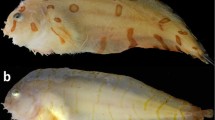Synopsis
Many North American stream fishes have a similar color pattern of four dark saddles against a light background. An interesting feature of the pattern, in addition to its widespread taxonomic distribution, is its consistent configuration. The interval between the first and second saddle is usually the largest, and the last (third) interval is the smallest. All saddled North American freshwater fishes live on uneven, rocky substrates, and nearly all live in flowing water. It is hypothesized that these fishes achieve crypsis through disruptive coloration; the light spaces between the saddles mimic rocks and the dark saddles appear as shadows or gaps between rocks. Saddles are spaced unevenly because rocks in streams are a mixture of sizes; a fish that mimics a series of rocks of similar sizes is more conspicuous than one that mimics rocks of different sizes. The placement of saddles was measured on five North American species. In four of five North American species measured (a sculpin and three darters), the longest spaces are towards the head where the body is also the widest, this is thought to enhance crypsis because pieces of gravel tend to be round or square. In the madtom, the saddle pattern tends more towards even spacing. The madtom may not rely on camouflage to the same extent as other species examined because of decreased predation pressure associated with being nocturnal and possessing sharp spines and venom glands.
Similar content being viewed by others
References cited
Barlow, G.W. 1963. Ethology of the Asian teleostBadis badis. II. Motivation and signal value of the colour patterns. Anim. Behav. 11: 97–105.
Barlow, G.W. 1972. The attitude of fish eye-lines in relation to body shape and to stripes and bars. Copeia 1972: 4–12.
Cott, H.B. 1966. Adaptive coloration in animals. Methuen and Co., London. 508 pp.
Endler, J.A. 1978. A predator's view of animal color patterns. Evol. Biol. 11: 319–364.
Endler, J.A. 1986. Defense against predators. pp. 109–134.In: M.E. Feder & G.V. Lauder (ed.) Predator-Prey Relationships, The University of Chicago Press, Chicago.
Fogden, M. 1974. Animals and their colors. Crown Publishers, New York. 72 pp.
Grady, J.M. & W.H. LeGrande. 1992. pp. 747–777.In: R.L. Mayden (ed.) Systematics, Historical Ecology, and North American Freshwater Fishes, Stanford University Press, Stanford.
Hailman, J.P. 1982. Concealment by stripes during movement and bars at rest: field evidence from color changes in a goatfish and a cornetfish. Copeia 1982: 454–455.
Kelly, D.H. 1961. Visual responses to time dependent stimuli. I. Amplitude sensitivity measurement. J. Opt. Soc. Amer. 51: 422–429.
Krebs, J.R. & N.B. Davies. 1987. An introduction to behavioural ecology. Blackwell Scientific Publications, Oxford. 389 pp.
Lythgoe, J.N. 1979. The ecology of vision. Clarendon Press, Oxford. 244 pp.
Moyle, P.B. & J.J. Cech. 1988. Fishes: an introduction to ichthyology. Prentice Hall, Engelwood Cliffs. 559 pp.
Page, L.M. 1983. Handbook of darters. TFH Publications, Inc., Neptune City. 271 pp.
Page, L.M. & B.M. Burr. 1991. A field guide to freshwater fishes of North America north of Mexico. Houghton Mifflin Co., Boston. 432 pp.
Smith, G.R. 1992. Phylogeny and biogeogrpahy of the Catostomidae, freshwater fishes of North America and Asia. pp. 778–826.In: R.L. Mayden (ed.) Systematics, Historical Ecology, and North American Freshwater Fishes, Stanford University Press, Stanford.
Thayer, A.H. 1896. The law which underlies protective coloration. The Auk 13: 124–129.
Thayer, G.H. 1909. Concealing coloration in the animal kingdom. An exposition of the laws of disguise through color and pattern. Macmillan and Co., London. 260 pp.
Author information
Authors and Affiliations
Rights and permissions
About this article
Cite this article
Armbruster, J.W., Page, L.M. Convergence of a cryptic saddle pattern in benthic freshwater fishes. Environ Biol Fish 45, 249–257 (1996). https://doi.org/10.1007/BF00003092
Received:
Accepted:
Issue Date:
DOI: https://doi.org/10.1007/BF00003092




